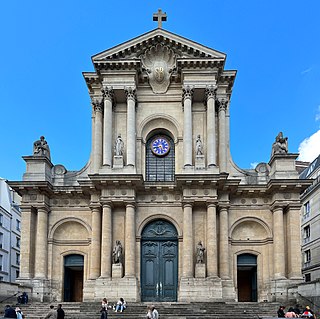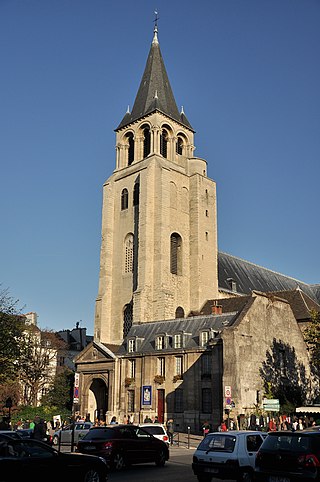
The Hôtel des Invalides, commonly called Les Invalides, is a complex of buildings in the 7th arrondissement of Paris, France, containing museums and monuments, all relating to the military history of France, as well as a hospital and an Old Soldiers' retirement home, the building's original purpose. The buildings house the Musée de l'Armée, the museum of the Army of France, the Musée des Plans-Reliefs, and the Musée d'Histoire Contemporaine. The complex also includes the Cathedral of Saint-Louis-des-Invalides, the national cathedral of the French military. It is adjacent to the Royal Chapel known as the Dôme des Invalides, the tallest church building in Paris at a height of 107 meters. The latter has been converted into a shrine to some of France's leading military figures, most notably the tomb of Napoleon.

Honfleur is a commune in the Calvados department in northwestern France. It is located on the southern bank of the estuary of the Seine across from Le Havre and very close to the exit of the Pont de Normandie. The people that inhabit Honfleur are called Honfleurais.

The Church of Saint-Germain-des-Prés is a Catholic parish church located in the Saint-Germain-des-Prés quarter of Paris. It was originally the church of a Benedictine abbey founded in 558 by Childebert I, the son of Clovis, King of the Franks. The abbey was destroyed by the Vikings, rebuilt, and renamed in the 8th century for Saint Germain, a 6th century bishop. It was rebuilt with elements in the new Gothic style in the 11th century, and was given the earliest flying buttresses in the Ile de France in the 12th century. It is considered the oldest existing church in Paris.

The Church of Saint-Séverin is a Roman Catholic church in the 5th arrondissement, or Latin Quarter, of Paris, on the lively tourist street Rue Saint-Séverin. It was constructed beginning in 1230, then, after a fire, rebuilt and enlarged in the 15th to 17th centuries in the Flamboyant Gothic style. It was the parish church for students at the University of Paris, and is one of the oldest churches that remains standing on the Left Bank.

Toulouse Cathedral is a Roman Catholic church located in the city of Toulouse, France. The cathedral is a national monument, and is the seat of the Archbishop of Toulouse. It has been listed since 1862 as a monument historique by the French Ministry of Culture.

The Église de la Sainte-Trinité is a Roman Catholic church located on the place d'Estienne d'Orves, at 3 rue de la Trinité, in the 9th arrondissement of Paris. It was built between 1861 and 1867 during the reign of Emperor Napoleon III, in the residential neighborhood of the Chaussée d'Antin. It is in the ornate Neo-Renaissance or Second Empire Style, with a highly visible 65-meter-tall belfry.

The Église Saint-Augustin de Paris is a Catholic church located at 46 boulevard Malesherbes in the 8th arrondissement of Paris. The church was built between 1860 and 1871 by the Paris city chief architect Victor Baltard. It was the first church in Paris to combine a cast-iron frame, fully visible, with stone construction. It was designed to provide a prominent landmark at the junction of two new boulevards built during Haussmann's renovation of Paris under Napoleon III. The closest métro station is Saint-Augustin

The Church of Saint-Roch is a 17th–18th-century French Baroque and classical style church in Paris, dedicated to Saint Roch. It is located at 284 rue Saint-Honoré, in the 1st arrondissement. The current church was built between 1653 and 1740.

Saint-Laurent is a Catholic church in the 10th arrondissement of Paris at 68 bis Boulevard de Magenta. A series of churches occupied the site since the 10th century. It is named for Saint Lawrence, an early Christian martyr who was executed in Rome by the Roman Emperor Valerian in 258 AD. It has been listed since 2016 as a monument historique by the French Ministry of Culture.

St Francis Xavier Church is a parish Roman Catholic church in the 7th arrondissement of Paris dedicated to Francis Xavier, the patron saint of missions. Built in the late 19th century, It gave its name to the nearby Metro station Saint-François-Xavier. It contains the tomb of Madeleine Sophie Barat, a French saint of the Catholic Church and founder of the Society of the Sacred Heart, a worldwide religious institute of educators. It is also known for its collection of Italian Baroque and Mannerist paintings, including a work by Tintoretto. The church was inscribed as an historic monument in 2018.

Saint-Ambroise is a Roman Catholic parish church located in the 11th arrondissement in eastern Paris. It is dedicated to St. Ambrose (339-377), an Italian statesman and theologian who served as Bishop of Milan.

The Church of Saint-Nicolas-des-Champs is a Catholic church in Paris' Third arrondissement. Early parts of the church, including the west front, built 1420–1480, are in the Flamboyant Gothic style, while later portions, including the south portal, mostly built 1576–86, are examples of French Renaissance architecture. It is notable particularly for its Renaissance carved sculpture, decoration and large collection of French Renaissance paintings in the interior.

Notre-Dame-de-Lorette is a Roman Catholic church located in the 9th arrondissement of Paris, It was built between 1823 and 1836 in the Neo-classical architectural style by architect Louis-Hippolyte Lebas, in a neighbourhood known as the New Athens, for its many artistic and scholarly residents in the 19th century, including George Sand, Pierre-Auguste Renoir, and Alexandre Dumas. While the exterior is classical and austere, the church interior is known for its rich collection of paintings, sculpture, and polychrome decoration.

Notre-Dame des Blancs-Manteaux is a Roman Catholic parish church at 12 Rue des Blancs-Manteaux in Le Marais, in the 4th arrondissement of Paris. It takes its name from the "Les Blancs-Manteaux", for the cloaks worn by the mendicant Augustinian Order of Servites, who founded the first church 1258. It was rebuilt between 1685 and 1689 in the French Baroque or French neoclassical style. It is noted for its remarkable carved wood pulpit (1749) and its collection of paintings and sculpture.

The city of Paris has notable examples of architecture from the Middle Ages to the 21st century. It was the birthplace of the Gothic style, and has important monuments of the French Renaissance, Classical revival, the Flamboyant style of the reign of Napoleon III, the Belle Époque, and the Art Nouveau style. The great Exposition Universelle (1889) and 1900 added Paris landmarks, including the Eiffel Tower and Grand Palais. In the 20th century, the Art Deco style of architecture first appeared in Paris, and Paris architects also influenced the postmodern architecture of the second half of the century.

Saint-Thomas-d'Aquin is a Roman Catholic church located in the 7th arrondissement of Paris, place Saint-Thomas-d’Aquin, between the rue du Bac and the boulevard Saint-Germain. The church is named for Saint Thomas Aquinas, a Dominican friar and priest, and influential philosopher and theologian in the 13th century. It was originally a chapel of an abbey of the Dominican order in Paris. Construction began in 1682, and the church was consecrated in 1682. The friars were expelled and the church was closed during the French Revolution, and was not returned to the Catholic church until 1802. During the 19th century, the City of Paris endowed the church with many fine examples of French religious art. The church was declared an Historic Monument in 1982. The newest campus of SciencesPo, 1, Saint-Thomas, stands next to it.

Romanesque architecture appeared in France at the end of the 10th century, with the development of feudal society and the rise and spread of monastic orders, particularly the Benedictines, which built many important abbeys and monasteries in the style. It continued to dominate religious architecture until the appearance of French Gothic architecture in the Île-de-France between about 1140 and 1150.

The Church of Saint-Julien-de-Brioude is a Roman Catholic church located in Marolles-en-Brie in the Val-de-Marne department in France. It is dedicated to St. Julian of Brioude and became a Class Historic Monument in 1909.

Notre-Dame de la Gare is a Roman Catholic parish church located on Place Jeanne-d'Arc in the 13th arrondissement of Paris, France. It was built between 1855 and 1864 in an area of Paris which was rapidly industrializing, and was located near the major freight railway station, or "Gare", which gave the church its name. The style was inspired by Romanesque architecture.

Notre-Dame-du-Travail is a Roman Catholic church located at 59 rue Vercingetorix in the 14th arrondissement of Paris. It was built between 1897 and 1902 for the largely working-class population of the Plaisance neighborhood. It is notable particularly for its exposed steel framework in the interior, resembling a factory, in contrast to the more traditional exterior. The entire church was registered as an historic monument on July 5, 2016.

























